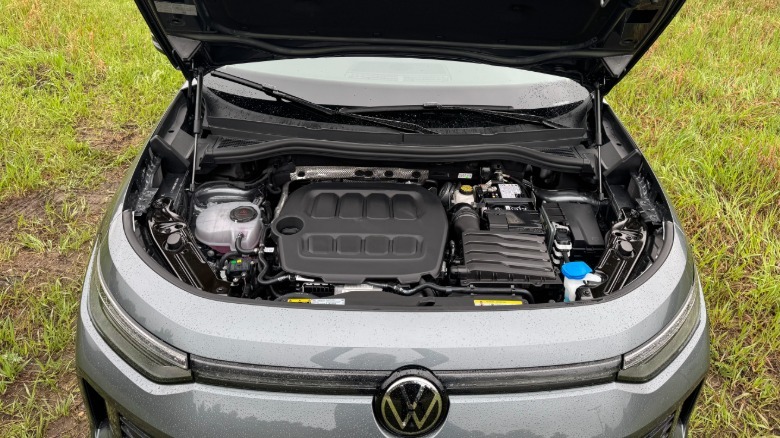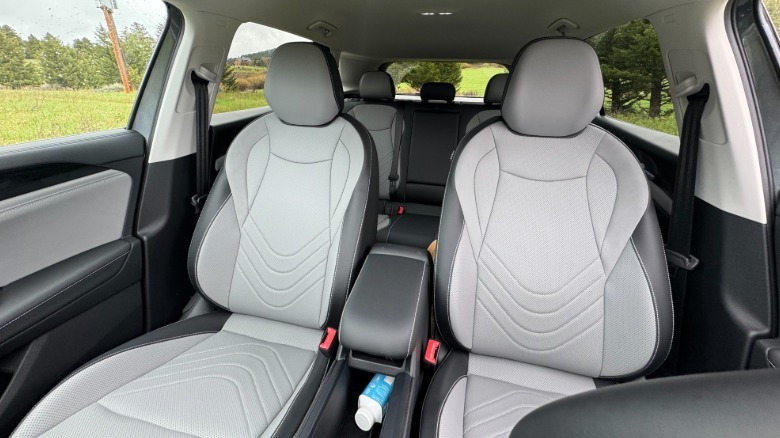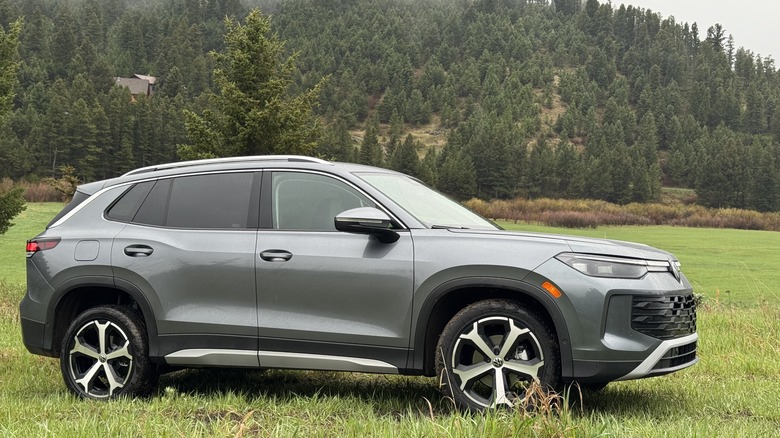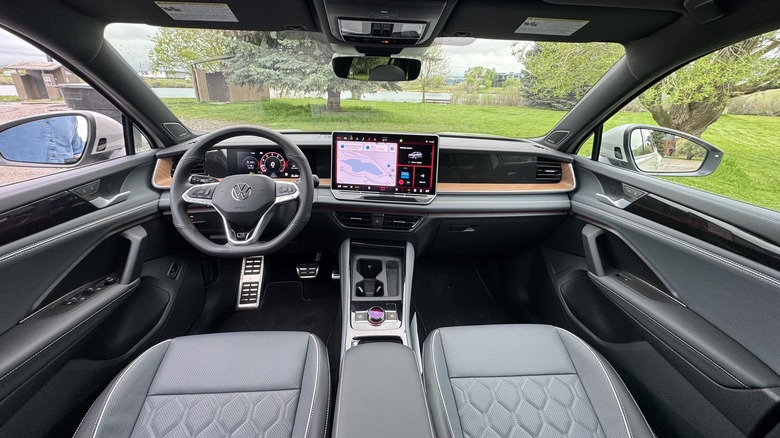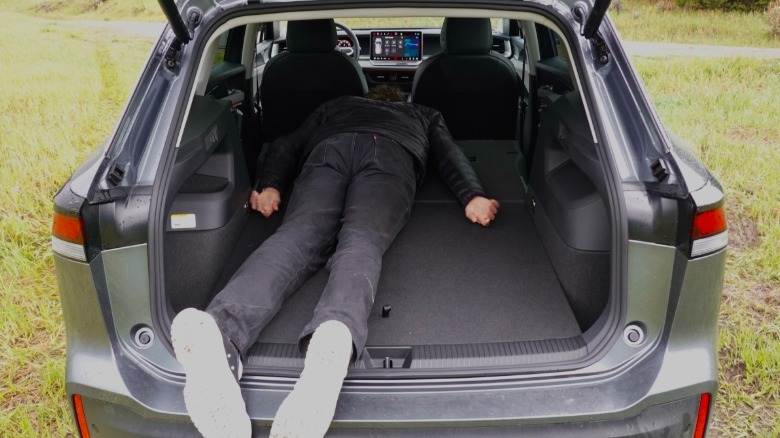When the original Volkswagen Tiguan was introduced to the U.S. market it occupied a niche of its own. Unlike its Japanese, American, and Korean competitors, the Tiguan was a distinctly European-flavored compact crossover that offered buyers a slightly upmarket alternative. It shared a significant portion of its DNA with VW’s iconic GTI, from its turbocharged engine to a premium interior design and sporty looks, and it provided a taut Germanic driving experience that seemed closer to a BMW than a Toyota. Unfortunately the Tiguan was smaller, pricier, and less fuel efficient than its mainstream competitors, which limited its appeal. Volkswagen flipped the Tiguan’s script with the second-generation car, which grew much larger and cheaper, but lost its predecessor’s distinctively European and fun-to-drive feel in favor of mainstream appeal in America’s unique market.
Goldilocks would agree that Volkswagen has found the sweet spot for the Tiguan’s new third generation, bringing back the original model’s refined driving dynamics and upscale interior appointments, while retaining the second-gen car’s spacious interior, competitive fuel economy, and appealing price. As a car nerd whose infatuation began with classic VWs, I’m happy to say the redesigned 2025 Tiguan is the nicest new Volkswagen product in a long time.
Full disclosure: Volkswagen wanted me to drive its new Tiguan so badly that it flew me out to Bozeman, Montana for 24 hours, put me up in a lovely hotel, and fed me bison and craft beer.
Volkswagen didn’t fumble its best-seller
It’s not that the outgoing second-generation Tiguan was a bad car, in fact it was the right car for an average of nearly 100,000 buyers since its introduction in 2018, but as mentioned above, it deviated from Volkswagen’s usual product ethos. Along with the Mark 6 Jetta and the final Passat, VW went too far in Americanizing that Tiguan, and die-hard Volkswagen fans and car enthusiasts alike bemoaned the decision to put materials quality and driving dynamics on the back burner. The impressive new third-gen Tiguan strikes a healthy balance among all factors..
The new Tiguan is shorter overall than the outgoing car and loses its optional third-row seats, but it shares the same wheelbase and thus has an interior that’s almost as spacious. Front and rear overhangs are tightened up and the curb weight is reduced by as much as 169 pounds, down to 3,563 in front-wheel-drive S trim.
To go along with this weight loss, the new Tiguan’s turbocharged 2.0-liter inline-4 gets a 17-horsepower boost to 201, but while all-wheel-drive models retain the same 221 pound-feet of torque, that number drops by 14 for front-wheel-drive Tiguans. Tiguans with front-wheel drive also get a different transmission than all-wheel-drive models, though both are eight-speed autos. The FWD Tiguan gets 25 mpg city, 32 mpg highway, and 28 mpg combined; going for all-wheel drive drops those numbers to 22, 30, and 25. If you want more power, a Tiguan SEL R-Line Turbo model is coming with 268 hp and 258 lb-ft.
The Tiguan SE is the trim most people buy
Other 2025 Tiguan reviews are likely to focus on the top-of-the-line SEL R-Line trim with its (admittedly impressive) massage function, massive 15-inch infotainment display, and backlit dash and door trim, but since the majority of Tiguan buyers spring for the SE trim, that’s what I spent most of my time in. The cheapest Tiguan you can buy in 2025 is the Tiguan S, which starts at $30,720 including $1,425 destination. Opting for Volkswagen’s 4Motion all-wheel drive adds $1,500 to S, SE, and SE R-Line Black trims, but top SEL R-Line trim comes standard with AWD.
All Tiguan trims get desirable features like wireless Apple CarPlay and Android Auto, LED headlights and taillights, two-zone climate control, a 10.25-inch digital gauge display, a big 12.9-inch infotainment touchscreen, Volkswagen’s IQ Drive suite of driver’s assistance features, a cooled wireless charger, heated seats, and a new kinda cool but kinda gimmicky Driving Experience Dial that doubles as a volume knob. The SE costs $33,720 and adds an 8-way power driver’s seat, an alarm, remote start, power tailgate, 10-color ambient lighting, leatherette seats, and19-inch wheels. There’s also the SE R-Line Black trim that costs $36,880 and adds a head-up display, black accents and R-Line badges, and a top-of-the-line SEL R-Line trim that takes things upmarket in a big way. For $41,180, SEL R-Line Tiguans get illuminated front and rear light bars, three-zone climate control, quilted leather ventilated seats with the best massage function this side of a full luxury car, 30-color ambient lighting, a Harmon-Kardon stereo, and massive 15-inch infotainment display.
A return to form
The front-wheel-drive Tiguan SE I drove came in at $33,720, and it thoroughly impressed me with its ample features and refined driving dynamics. Despite having a different transmission and lower torque output than the all-wheel-drive model, the FWD Tiguan felt noticeably peppier and more playful than the 4Motion-equipped models I sampled.
The new Tiguan SE feels solid and substantial on the road, with a well-tuned suspension that quietly absorbs bumps and keeps things under control when hustling around twisty roads. I didn’t find the steering feel artificially heavy and numb, and not particularly enjoyable, but this ain’t a sports car, it’s a family car. In front-wheel-drive form you do have to battle some torque steer under heavy throttle, but it feels lively and eager to play.
From inside the cabin, I was thoroughly impressed by how unintrusive engine noise was, and the engine noise you do hear sounds smooth and refined unlike many of its competitors. I was unable to feel a difference between the transmissions; both respond well to throttle pedal inputs, though the actual handoff between gears feels a bit hesitant. There is no way to select your own gears in the new Tiguan — the new steering column-mounted gear selector comes straight out of VW’s EVs so you can’t use it to shift gears, and it doesn’t have paddle shifters, which I guess is fine for a family car, but I still wanted to be able to flick through some gears. That said, it’s miles better than a CVT, so props to VW for sticking to a real transmission with real gears.
Stepping up the interior
The interior of the new Tiguan is a lovely place to spend time, regardless of what trim level you choose. Even in lower SE form, the seats are covered in a convincing leatherette, all the surfaces that front seat passengers touch feel soft and squishy, and they look expensive, too. My SE press car didn’t have the optional panoramic sunroof, but headroom was still less generous than some competitors. When I drove the SEL R-Line trim with the pano roof, my hair was brushing against the headliner despite having the seat in its lowest position, so if you’ve got a long torso make sure you fit comfortably. Other than limited front seat headroom, I was able to comfortably sit behind my driving position which is no mean feat given that I’m 6-foot-8 with very long legs. If you’re a leggy family the Tiguan will be a great choice for you.
That gimmicky new Driving Experience Dial lives on the center console between the front seats, and defaults to being a volume dial, but push the dial and it becomes a drive mode selector. Volkswagen has introduced what it calls “Atmospheres” that holistically change the vibe inside the car, from the ambient light color to the digital gauge color to the audio volume alongside changing the drive modes. It’s cute, but gimmicky.
The SE’s 10-color ambient lighting is a nice touch for a lower trim level, and its 12.9-inch infotainment screen is more than enough screen for this car. Though the new steering wheel is fitted with physical buttons that are a cinch to use, the new Tiguan is saddled with Volkswagen’s existing infotainment system. That means you have to interact with its dreadful touch-sensitive sliders to change climate control temperatures, and it requires too many taps to change fan speeds, but you get used to it quickly and at least it’s backlit now. The standard wireless Apple CarPlay worked great during my short drive, and the cooled wireless charger works well.
Premium look and feel for great prices
Overall, the new 2025 Volkswagen Tiguan is a mighty impressive product. It’s a big step up from the current Tiguan in basically every way, and prices don’t increase more than $1,000 for any trim level over the 2024 car. While the SEL R-Line adds some enticing and bougie features, more affordable SE models are plenty well-equipped. In a crowded segment that’s flush with great options, the new Tiguan brings back Volkswagen’s distinctively Teutonic driving experience and interior space while retaining its American-sized interior. The Tiguan may lose its third row of seats for 2025, but those seats were downright dinky in the first place, and if you need three rows of seats you can always go for Volkswagen’s spacious Atlas.
The new 2025 Tiguan is on sale now, and finally sheds all qualifiers. I’m sure some arms of the Volkswagen Group won’t be too pleased that I’m saying this, but it feels like an affordably priced Audi Q5, and I wholeheartedly recommend checking it out if you’re shopping for a compact crossover.

